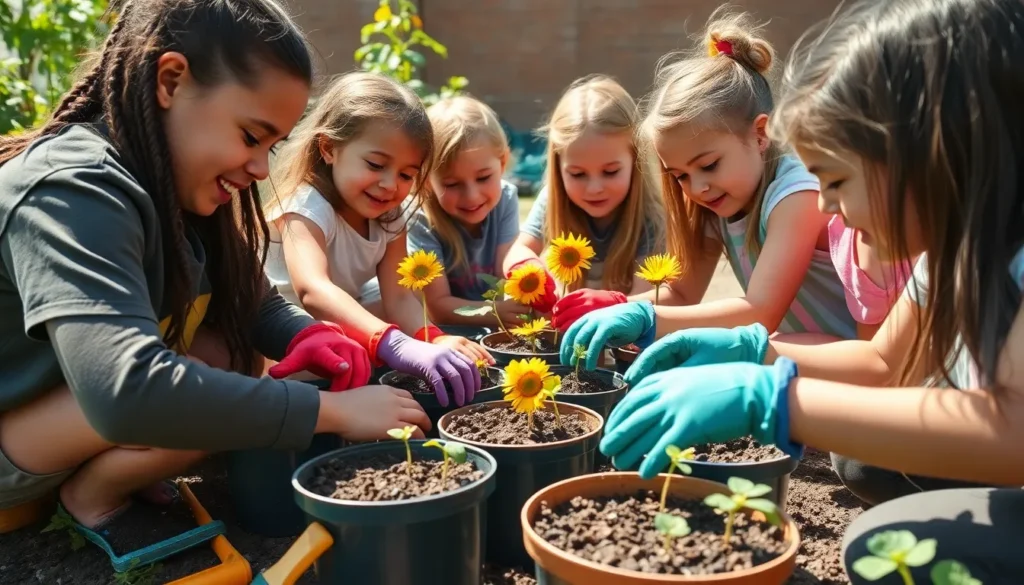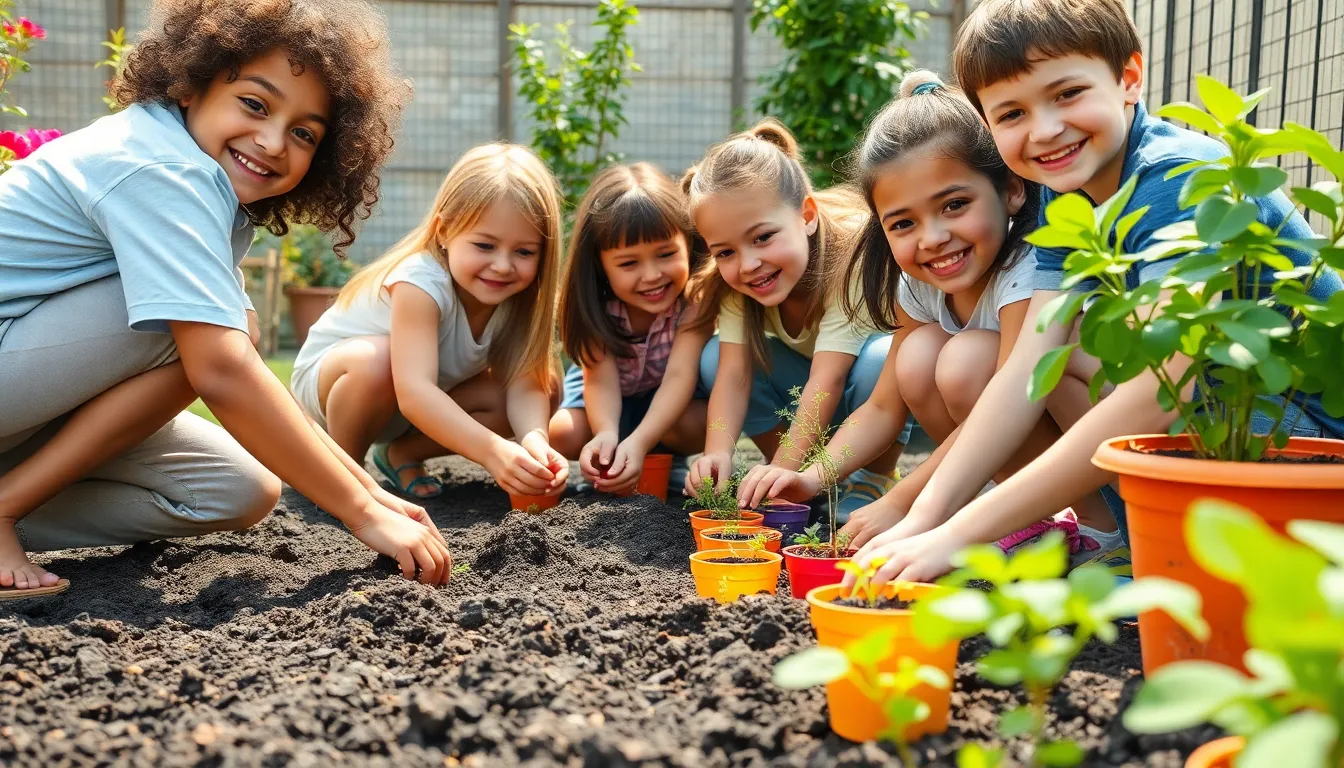Table of Contents
ToggleIn a world where instant gratification reigns supreme, the art of patience often gets lost. But what if planting seeds could teach not just the joy of gardening but also the value of waiting for something wonderful to blossom? Picture this: a tiny seed in the dirt, dreaming of becoming a magnificent sunflower. With a little care, water, and sunlight, that dream can become a reality.
Overview of Planting Seeds Lesson
The planting seeds lesson emphasizes patience and care, showcasing how nurturing a seed cultivates not just a plant but also valuable life skills. Students engage in hands-on activities that allow them to observe the growth process and reflect on their experiences. Learning how to plant seeds involves understanding the requirements for growth, such as sunlight and water.
An essential part of this lesson involves hands-on planting. Educators guide students through steps like selecting the right seeds, preparing the soil, and watering. Each step demonstrates the importance of providing the right conditions for healthy growth. Selecting seeds like sunflowers offers a vivid example, as they grow tall and vibrant, serving as a tangible representation of patience in action.
Observation plays a crucial role in this lesson. Participants are encouraged to track their seeds’ growth, noting changes weekly. Keeping a growth journal helps them articulate their observations and feelings, reinforcing the importance of patience as they witness gradual transformations.
Collaboration enriches the learning experience. Students often work in pairs or groups, sharing responsibilities like watering and monitoring growth. Teamwork not only promotes social skills but also highlights the shared journey of nurturing a plant.
Engaging discussions surround the theme of instant gratification versus delayed rewards. Participants reflect on their expectations and feelings during the growth process. This dialogue reinforces the lesson’s core message: real beauty emerges through consistent care and persistence.
Benefits of Teaching Planting Seeds
Teaching planting seeds offers multiple benefits that contribute to personal growth and educational development. Students not only develop a connection with nature but also gain essential knowledge and skills.
Engaging with Nature
Engagement with nature fosters a sense of wonder and curiosity about the environment. Children experience firsthand how seeds transform into plants, enhancing their appreciation for living systems. Direct interaction with soil, water, and sunlight deepens understanding of ecosystems. Observing changes over time encourages emotional connection to the natural world. Simple activities such as watering or monitoring growth build responsibility, nurturing a sense of accomplishment. Nurturing plants reinforces respect for all forms of life while promoting outdoor activities.
Enhancing Scientific Understanding
Scientific understanding improves as students explore the biology of plant growth. They learn essential concepts like photosynthesis, germination, and nutrient absorption. Discussing these themes enhances critical thinking and helps connect theoretical knowledge to practical experiences. Tracking growth over weeks invites observations and questions, sparking curiosity. Performing experiments, such as changing light conditions, reveals how plants respond to different stimuli. Collaborative classroom discussions about findings build communication skills and cultivate teamwork. Overall, this hands-on experience solidifies scientific concepts, providing a strong foundation for future learning.
Key Components of a Successful Lesson
Successful lessons on planting seeds integrate specific materials and clear, step-by-step instructions. These components enhance the overall learning experience.
Materials Needed
Essential materials include seed packets, soil, pots, watering cans, and gardening tools. Students require journals for tracking growth and observations. Planting medium must be added to ensure seeds have proper nutrition. Sunlight sources like grow lights support optimal growth conditions for indoor lessons. Encourage the use of markers for labeling pots to maintain organization. A thermometer helps in monitoring the temperature, ensuring a suitable environment for seed germination.
Step-by-Step Instructions
Begin by selecting seeds based on desired plants, such as sunflowers or beans. Next, prepare the pots with soil, filling them to the appropriate level. Students should plant seeds at the recommended depth, ensuring correct spacing between each seed. Water thoroughly after planting, but avoid overwatering. Place pots in a sunny location or under grow lights to provide ample light. Encourage regular monitoring, noting observations in journals. Finally, invite students to reflect on their growth experiences during group discussions, fostering collaboration and enhancing their understanding of patience and persistence.
Tips for Effective Implementation
Effective implementation of a planting seeds lesson involves considering diverse learning needs and enhancing student engagement through technology.
Adapting for Different Age Groups
Tailoring the lesson for various age groups creates a more engaging experience. Younger students benefit from simple activities like planting seeds in cups and monitoring growth. Using visuals helps them grasp concepts like sunlight and water. Older students can delve into scientific principles like germination and photosynthesis, enabling deeper discussions. Encouraging them to create detailed journals fosters reflection on their growth journey. Adjusting the complexity of tasks keeps all students interested and involved.
Incorporating Technology
Integrating technology enriches the planting seeds lesson significantly. Utilizing apps for tracking growth offers a modern twist on journaling. Students can take pictures of their plants and document changes over time, promoting digital literacy skills. Virtual field trips can showcase different ecosystems, sparking curiosity about plants in diverse environments. Online forums and discussion boards enable students to share findings and engage in rich dialogues. Highlighting these digital tools modernizes the learning experience while maintaining core educational values.
Conclusion
Planting seeds serves as a powerful metaphor for life’s lessons in patience and growth. Through hands-on activities and collaborative discussions, students not only learn about gardening but also develop essential skills that extend beyond the classroom. This lesson fosters a deep connection with nature while encouraging critical thinking and teamwork.
As they nurture their seeds, they experience the rewards of persistence and care. The journey from seed to plant mirrors personal growth, reminding them that true beauty often requires time and dedication. By embracing this process, students cultivate a lasting appreciation for the environment and the importance of patience in achieving their goals.








